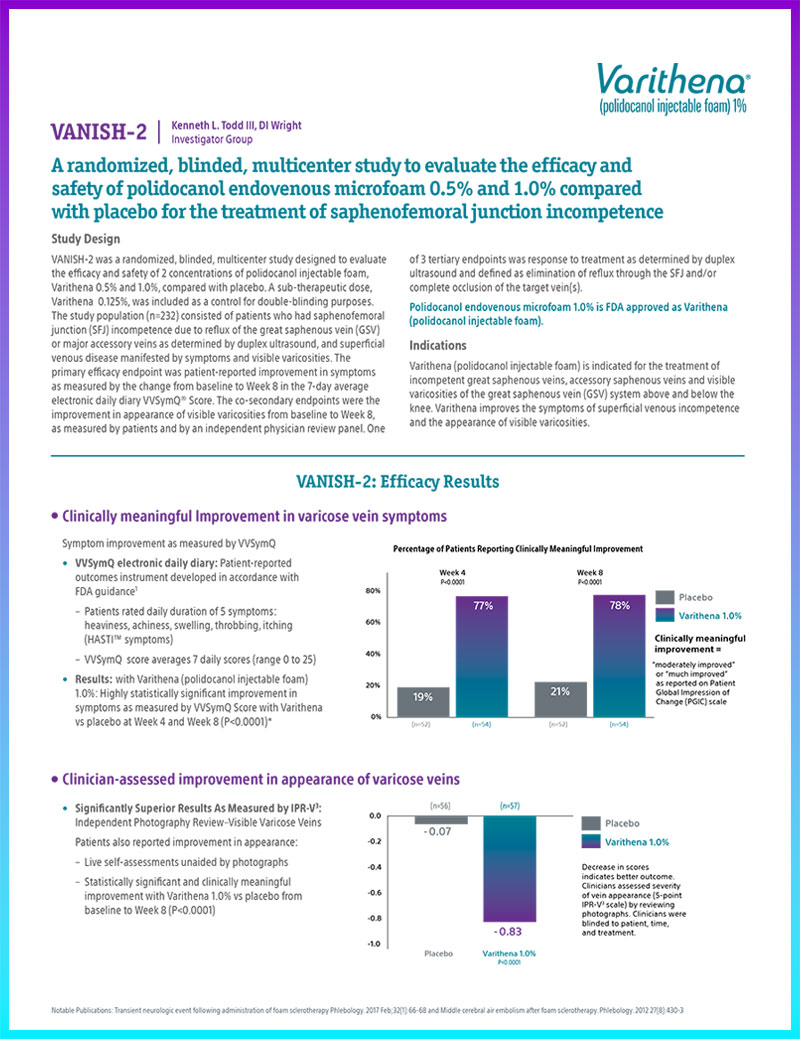Study design
VANISH-2 was a randomized, blinded, multicenter study designed to evaluate the efficacy and safety of 2 concentrations of polidocanol injectable foam, Varithena 0.5% and 1.0%, compared with placebo. A sub-therapeutic dose, Varithena 0.125%, was included as a control for double-blinding purposes. The study population (n=232) consisted of patients who had saphenofemoral junction (SFJ) incompetence due to reflux of the great saphenous vein (GSV) or major accessory veins as determined by duplex ultrasound, and superficial venous disease manifested by symptoms and visible varicosities. The primary efficacy endpoint was patient-reported improvement in symptoms as measured by the change from baseline to week 8 in the 7-day average electronic daily diary VVSymQ® Score. The co-secondary endpoints were the improvement in appearance of visible varicosities from baseline to week 8, as measured by patients and by an independent physician review panel. One of three tertiary endpoints was response to treatment as determined by duplex ultrasound and defined as elimination of reflux through the SFJ and/or complete occlusion of the target vein(s).
Polidocanol endovenous microfoam 1.0% is FDA approved as Varithena (polidocanol injectable foam) 1%.
Indications
Varithena (polidocanol injectable foam) 1% is indicated for the treatment of incompetent great saphenous veins, accessory saphenous veins and visible varicosities of the great saphenous vein (GSV) system above and below the knee. Varithena improves the symptoms of superficial venous incompetence and the appearance of visible varicosities.
VANISH-2: Efficacy results
Clinically meaningful improvement in varicose vein symptoms
Symptom improvement as measured by VVSymQ
- VVSymQ electronic daily diary: Patient-reported outcomes instrument developed in accordance with FDA guidance1
- Patients rated daily duration of 5 symptoms: heaviness, achiness, swelling, throbbing, itching (HASTI™ symptoms)
- VVSymQ score averages 7 daily scores (range 0 to 25)
- Results: with Varithena (polidocanol injectable foam) 1.0%: Highly statistically significant improvement in symptoms as measured by VVSymQ Score with Varithena vs. placebo at Week 4 and Week 8 (P<0.0001)*
Percent of patients reporting clinically meaningful improvement

Clinician-assessed improvement in appearance of varicose veins
- Significantly superior results as measured by IPR-V3:
Independent Photography Review–Visible Varicose Veins
Patients also reported improvement in appearance:- Live self-assessments unaided by photographs
- Statistically significant and clinically meaningful improvement with Varithena 1.0% vs placebo from baseline to Week 8 (P<0.0001)

Physiologic response as measured by duplex ultrasound
The authors state that “a more rigorous duplex response definition than typically applied was used in this design.” Response was defined as elimination of reflux through the SFJ and/or complete occlusion of all incompetent target trunk vein(s): GSV, AASV, and/or PASV.* Response was achieved in 86% of patients treated with Varithena 1.0% at week 8, compared with 60% of the control group, who received a sub-therapeutic dose (Varithena 0.125%) created for double-blinding purposes.
*AASV: Anterior accessory saphenous vein; PASV: Posterior accessory saphenous vein
Only 3.4% of patients required re-treatment of the same vein after initial treatment.
VANISH-2: Safety profile
Safety profile points of interest
Adverse events (AEs) in this study were mostly mild or moderate (95% for all dose groups). No unexpected or drug-related serious AEs at any dose were reported.
- No pulmonary emboli reported
- No clinically important neurologic or visual adverse events
- No cerebrovascular events or migraines
- No reported cases of anaphylactic shock
VANISH-2: Conclusions
Varithena:
- Provided clinically meaningful improvement* in symptoms and appearance in patients with incompetent great saphenous veins (GSV), accessory saphenous veins, and visible varicosities of the GSV system. Improvement was measured by a patient global impression of change (PGIC) questionnaire at week 8
- Was an effective and comprehensive minimally invasive treatment for a wide range of varicose veins (CEAP clinical class C2 to C6 and GSV diameters from 3.1 to 19.4 mm)
Study design: VANISH-2 was a randomized, blinded, multicenter study designed to evaluate the efficacy and safety of 2 concentrations of polidocanol injectable foam, Varithena 0.5% and 1.0%, compared with placebo. The primary efficacy endpoint was patient-reported improvement in symptoms as measured by the change from baseline to week 8 in the 7-day average electronic daily diary VVSymQ Score. The co-secondary endpoints were the improvement in appearance of visible varicosities from baseline to week 8, as measured by patients and by an independent physician review panel - Was associated with mild or moderate, manageable side effects
Important safety information: The most common adverse events observed were pain/discomfort in extremity, retained coagulum, injection site hematoma or pain, common femoral vein thrombus extension, superficial thrombophlebitis, and deep vein thrombosis
*Percent of patients who reported their symptoms (or appearance of varicose veins) had “moderately improved” or “much improved” compared with baseline
References
1. US Food and Drug Administration. Guidance for Industry: Patient-Reported Outcome Measures: Use in Medical Product Development to Support Labeling Claims. Washington, DC: US Department of Health and Human Services; 2009.
